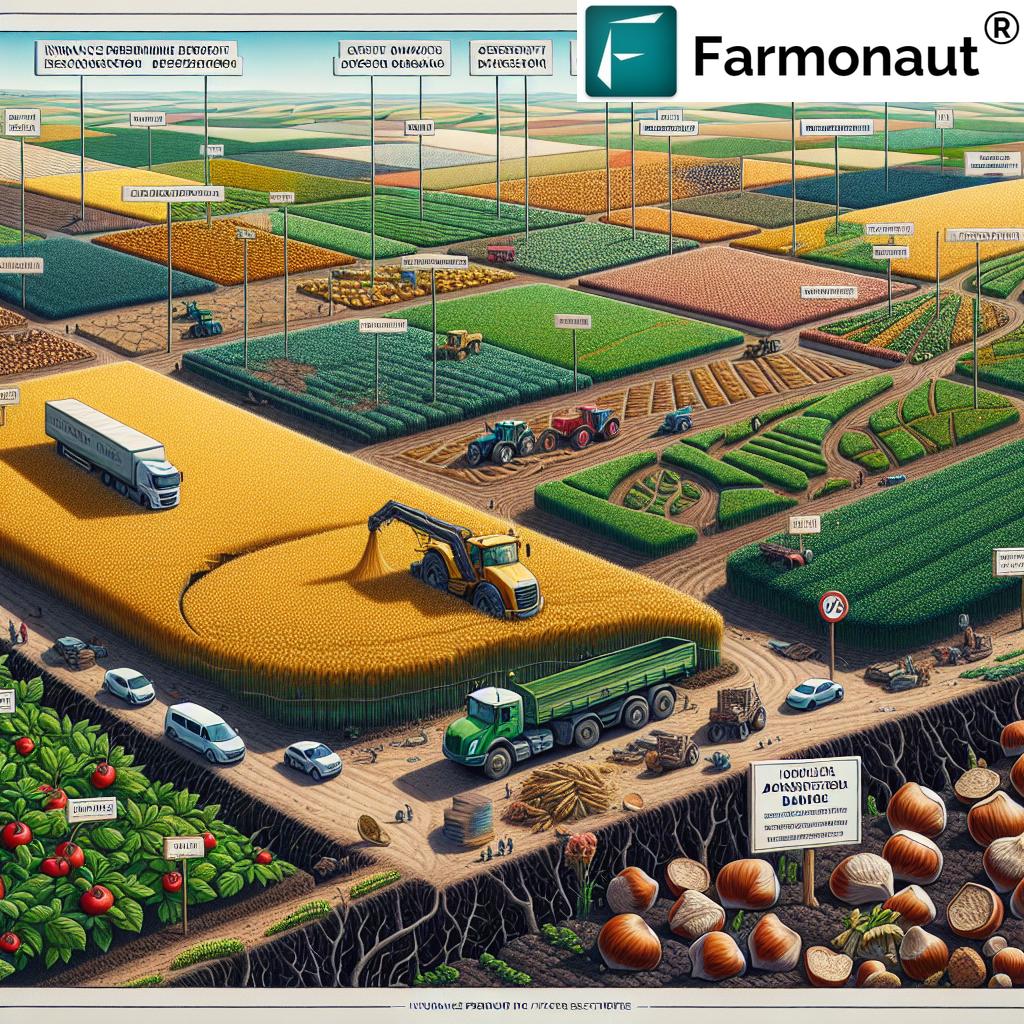Table of Contents
- Key Trivia: The Importance of Hand Tools in Indian Agriculture
- Introduction: The Backbone of Indian Agriculture
- The Impact of Hand Tools in Sustainable & Precision Farming
- Modern Innovations in Agriculture Hand Tools
- Government Initiatives and Empowerment of Small Farmers
- 7 Top Farming Hand Tools in India
- Comparison Table: 7 Top Farming Hand Tools for Sustainable Agriculture in India
- Digital Transformation: Satellite & Smart Tools Integration
- Key Trivia: Modern Hand Tools Advance Sustainability
- The Future of Agriculture Hand Tools in India
- Frequently Asked Questions (FAQ)
- Conclusion: Hand Tools as Catalysts for Sustainability
Key Trivia: The Importance of Hand Tools in Indian Agriculture
“Over 80% of Indian small farmers rely on hand tools for sustainable, eco-friendly farming practices.”
Agriculture Hand Tools in India: 7 Top Farming Hand Tools

Agriculture continues to be the backbone of rural economies in India—a country where small and marginal farmers constitute a significant share of the farming community. In 2025, despite rapid technological advancements and increased mechanization, agriculture hand tools in India remain indispensable for efficient farming operations. Not only are these hand farming tools widely used due to their affordability, ease of operation, and adaptability, but they also occupy a central role in sustainable farming practices and precision agriculture—fostering eco-friendly methods and organic growth amidst increasing global demand for food security.
Agriculture hand tools—hoes, sickles, spades, ploughshares, and more—have been the cornerstone of Indian farming since time immemorial. Their presence on our smallholder farms is not merely historical: these tools enable farmers to prepare soil, sow seeds, uproot weeds, irrigate, and harvest crops across various types of land and climate conditions, granting unmatched flexibility and resilience.
As we move forward into 2025 and beyond, the role of hand tools in agriculture only widens. Material innovation and smarter ergonomic designs are redefining their usability, making farming more efficient and safer for Indian farmers. Government initiatives and private innovations are further supporting the widespread adoption and modernization of these tools, reaffirming their status as vital gears in India’s agri-ecosystem.
The Role of Agriculture Hand Tools in Sustainable & Precision Farming
Sustainability and precision are two dominant themes driving agriculture today—especially as farmers turn towards organic and environmentally friendly methods. Hand tools in agriculture are remarkably aligned with these practices for several reasons:
- Minimal Soil Disturbance: Manual tools allow farmers to prepare land, sow, and weed without harming valuable soil microorganisms, thereby preserving soil health.
- Selective & Controlled Operations: Tasks such as manual weeding, irrigation, and harvesting benefit from the precision and flexibility of hand farming tools, important for intercropping, mixed farms, and fragile ecosystems.
- Reduced Chemical Dependency: Selective manual operations mean less need for herbicides and pesticides, endorsing environmentally friendly and organic farming.
- Adaptable for Small Plots: Especially in Indian contexts, where landholdings are fragmented and small, mechanized machinery may be unfeasible; hand tools offer affordable, scalable solutions.
- Supports Crop Diversity: For farms with mixed or intercropped fields, machines may damage young shoots or companion plants, whereas hand tools enable careful, targeted work.
As the demand for chemical-free, sustainably-grown food rises, India’s hand tools enable farmers to adopt practices that keep ecosystems, consumers, and rural economies healthy.
Modern Design & Innovation in Agriculture Hand Tools
While traditional hand tools still dominate markets, modern innovations are transforming how farmers experience manual labor. Here’s how hand farming tools have evolved for 2025:
- Material Innovation: New-age tools are forged from lightweight, durable materials—such as high-grade steel and composite plastics. These upgrades enhance both performance and longevity, while reducing farmer fatigue.
- Ergonomic Design: Emerging ergonomic models prioritize comfort by reducing strain on hands, wrists, and backs, making farm work more sustainable over time.
- Enhanced Precision: Some hand tools now offer built-in measuring guides, replaceable blades, and even compatibility with digital sensors.
- Localized Manufacturing: Accessibility is increased by localized manufacturing units, providing regionally appropriate tools at lower costs, supporting rural employment and skill development.
These innovations, coupled with increased private and public sector focus, are making hand tools even more relevant and effective for Indian farmers.
Government Support, Rural Empowerment & Accessibility
The Indian government and various private initiatives are integral to increasing the reach of modern farming hand tools. Government programs offer:
- Subsidies: On improved tools for small and marginal farmers, making them affordable for rural communities.
- Awareness: Conducting educational and skill-development programs on tool maintenance, use, and sustainable practices.
- Local Production Support: Promoting rural manufacturing of hand tools enhances employment and tool accessibility in remote regions.
- Integration with Indigenous Knowledge: Combining traditional wisdom with modern designs fosters innovation and adaptability to regional conditions.
- Smart Attachments: Recent schemes are investing in digital sensor attachments for soil and crop health monitoring, bridging manual work and digital agriculture.
Such interventions are pivotal for enriching farmer livelihoods, making hand tools a sustainable solution for smallholder farms in India.
Looking for advanced satellite insights for your farm? Our Large Scale Farm Management Platform provides sophisticated monitoring using satellite data, helping farmers track crop health, environmental conditions, and optimize farm inputs—making sustainable farming easier and more data-driven.
7 Top Farming Hand Tools in India for Sustainable Agriculture
Agriculture hand tools in India have a storied legacy but have evolved to meet modern needs. Here are the top 7 tools empowering Indian farmers for eco-friendly, efficient farming in 2025:
-
Hoe (Kudal)
The hoe is a classic tool for land preparation, tilling, and weed management. Newer variants are lighter and ergonomically designed for comfortable, all-day use.
- Primary Uses: Breaking up soil, mixing nutrients, surface tilling, removing weeds.
- Key Sustainable Features: Enables minimal soil disturbance, supports manual weed control, and reduces chemical herbicide dependency.
- Modern Upgrades: Composite handles, stainless steel blades, and angle adjustments for diverse Indian soils.
-
Sickle (Hasia)
The quintessential manual harvesting tool for centuries, the sickle features a curved blade, perfect for precise harvesting and grass cutting.
- Primary Uses: Harvesting grains, fodder, and pruning soft plant material.
- Key Sustainable Features: Facilitates selective harvesting, minimizes crop wastage, and allows for detailed post-harvest sorting.
- Modern Upgrades: Lightweight steel alloys, slip-resistant grips, and enhanced blade sharpness.
-
Spade (Phawda)
A must-have in every farming operation, the spade is utilized for digging, turning earth, and making trenches.
- Primary Uses: Digging holes, soil turning, compost mixing, irrigation trenches.
- Key Sustainable Features: Supports efficient composting and water management without fuel-driven machinery, improving soil structure.
- Modern Upgrades: Rust-resistant coatings, longer handles, and reinforced heads for longevity.
-
Dibber/Dibbler
The dibber or dibbler is a pointed stick or rod, increasingly upgraded with markers, designed for sowing seeds or planting seedlings at precise depths.
- Primary Uses: Sowing seeds, planting bulbs, transplanting seedlings.
- Key Sustainable Features: Ensures proper seed depth, promotes uniform crop emergence, minimizes seed waste.
- Modern Upgrades: Marked measurements, replaceable tips, and lightweight designs for quick, reliable planting.
-
Hand Weeder
Hand weeders are slim, forked tools designed to remove weeds with minimal soil disturbance—a key practice for organic farming.
- Primary Uses: Uprooting weeds, grass removal, tidying beds and rows.
- Key Sustainable Features: Reduces reliance on weedicides, enables manual weed management, and keeps soils healthy.
- Modern Upgrades: Ergonomic handles, rust-proof materials, and improved leverage.
-
Garden Fork (Khurpi)
The garden fork—locally called khurpi—is perfect for loosening, aerating, and turning soil in narrow beds where large machines cannot reach.
- Primary Uses: Aerating, soil turning, compost application in close spaces or raised beds.
- Key Sustainable Features: Facilitates healthier root systems, reduces need for mechanical tilling, and supports no-till farming approaches.
- Modern Upgrades: Shortened shafts for easy maneuvering, corrosion-resistance, and improved tines.
-
Hand Pruner/Harvesting Knife
Essential for orchards and vegetable farms, hand pruners (or harvesting knives) deliver sharp, targeted cuts for pruning, harvesting, and plant training.
- Primary Uses: Pruning branches, harvesting fruits and vegetables, precision trimming.
- Key Sustainable Features: Allows for selective, damage-free harvesting and plant health management.
- Modern Upgrades: High-carbon steel blades, spring-action grips, safety lock mechanisms.
Curious about resource and fleet optimization for your agri-business? Explore Farmonaut’s Fleet Management Tools to effectively manage vehicles and reduce farm operational costs—ideal for Indian farms scaling up or diversifying activities.
Comparison Table of the 7 Top Farming Hand Tools for Sustainable Agriculture in India
| Hand Tool Name | Primary Use | Key Sustainable Feature | Estimated Cost (INR) | Ease of Use (1–5) | Suitability for Small Farmers | Estimated Environmental Impact |
|---|---|---|---|---|---|---|
| Hoe (Kudal) | Tilling, Weeding, Land Preparation | Minimal soil disturbance, enables organic practices | 200–600 | 4 | Yes | Low |
| Sickle (Hasia) | Harvesting, Cutting Fodder | Selective/controlled harvesting, reduces waste | 100–300 | 5 | Yes | Low |
| Spade (Phawda) | Digging, Compost Mixing, Irrigation | Supports composting and water management | 250–700 | 4 | Yes | Low |
| Dibber/Dibbler | Seed Sowing, Planting | Ensures uniform crop emergence, reduces seed waste | 100–250 | 5 | Yes | Low |
| Hand Weeder | Weeding, Grass Removal | Manual weed elimination, no chemicals required | 150–350 | 5 | Yes | Low |
| Garden Fork (Khurpi) | Soil Aeration, Compost Application | Prevents soil compaction, supports root health | 250–500 | 4 | Yes | Low |
| Hand Pruner/Harvesting Knife | Pruning, Precision Harvesting | Selective trimming, reduces plant stress | 300–700 | 4 | Yes | Low |
Digital Transformation: Integrating Hand Tools with Smart Agriculture Platforms
The next frontier for agriculture hand tools in india is smart integration with digital platforms. While manual tools enable precise, eco-friendly operations on the ground, digital agriculture technologies—like those provided by Farmonaut—empower farmers with actionable insights on weather, soil health, and crop conditions, further optimizing field activities.
- Farmonaut’s Satellite Monitoring delivers real-time satellite imagery for Indian farmers via web and mobile apps, supporting sowing, irrigation, and harvesting decisions for optimal productivity and sustainable management.
- AI Advisory Systems guide on the best timing for operations conducted with hand tools, informing when and where soil preparation, weeding, or harvesting may reap maximum benefits.
-
Blockchain Traceability ensures transparent and secure records of all practices, including manual operations—helping Indian farmers meet stringent export and organic certification requirements.
Learn more about our transparent supply chain solution:
Farmonaut Product Traceability
-
Environmental Impact Monitoring lets farmers track the reduction in carbon footprint associated with sustainable use of hand tools over intensive machinery, an increasingly vital metric as global standards shift towards low-emission food production.
Calculate your farm’s carbon impact with Farmonaut Carbon Footprinting Tools. - API Accessibility for Farmonaut API and Developer Docs empowers developers and agri-businesses to build custom solutions integrating both digital and manual management for smarter, efficient farming in India.
Access Farmonaut’s satellite-powered solutions from your preferred device—


Key Trivia: Modern Hand Tools Advance Sustainability
“Modern hand tools can increase farm labor efficiency by up to 30% while reducing environmental impact.”
The Future of Agriculture Hand Tools in India: Integration, Smart Design, and Sustainability
Even as mechanized farming grows, agriculture hand tools in india will remain deeply relevant. What will define their future?
- Smart Enhancements: We may soon see hand tools paired with sensor-based attachments, helping farmers log soil data, track work patterns, and receive digital alerts—bridging tradition and tech.
- Further Ergonomics: Greater emphasis on reducing injury risk and farmer fatigue, with handles shaped for comfort and lighter, tougher builds.
- Sustainability by Design: New materials that are recyclable, biodegradable, or even made from agri-waste are likely, reinforcing the alignment of hand farming tools with global eco-friendly practices.
- Hybrid Usage: Combining manual tools with app-based guidance (e.g., when to weed or irrigate), boosting both outcomes and awareness for Indian farmers.
- Inclusive Innovation: Designing tools for women, youths, and differently-abled farmers to participate equally in agriculture.
What remains clear? The significance of farming hand tools in India extends well into 2025 and beyond, not just for day-to-day farm work but as adaptable allies in transitioning towards a smarter, greener agri-future.
Want real-time AI recommendations for climate-smart crop care on your farm? Our platform includes Crop Plantation & Forest Advisory—custom insights for timing manual interventions like sowing, weeding, and harvesting.
Try Farmonaut’s Affordable Satellite and AI-Based Advisory
Frequently Asked Questions (FAQ): Agriculture Hand Tools in India
1. Why are agriculture hand tools still indispensable for Indian farmers?
Despite advances in mechanization, hand tools in agriculture remain essential for Indian farmers due to affordability, flexibility, and adaptability to small or fragmented lands. They also support more sustainable, organic, and precision farming techniques.
2. Which hand tools are considered best for sustainable farming in India?
The best agriculture hand tools include hoes, sickles, spades, dibblers, hand weeders, garden forks (khurpi), and hand pruners—each enabling efficient and eco-friendly operations for different crop and soil types.
3. How are traditional tools being improved or modernized?
Modern agriculture hand tools use high-grade steel, composites, and ergonomic designs, making them lighter, more durable, and comfortable—helping reduce farmer fatigue and boost productivity.
4. What government initiatives are supporting the adoption of improved hand tools?
Government programs offer subsidies for quality tools, promote rural manufacturing, and provide training for tool maintenance. Efforts are also underway to integrate smart attachments with manual tools for data collection and digital agriculture alignment.
5. How can digital and manual tools be used together?
Digital applications, like Farmonaut’s satellite monitoring and AI advisory systems, can guide the timing, location, and method of manual farm interventions, ensuring maximum impact with minimal effort and environmental stress.
6. What is the cost range for modern hand tools in India?
Most high-quality hand tools cost between INR 100–700, making them accessible to the majority of small and marginal Indian farmers.
7. Why is sustainable hand tool usage critical for the future of Indian agriculture?
Sustainable hand tool usage reduces chemical input, safeguards soil health, promotes biodiversity, and enables inclusive participation—key to India’s long-term food security and rural economic resilience.
Conclusion: Hand Tools—The Heartbeat of Progressive, Sustainable Agriculture in India
As India advances toward a digital and globally connected agricultural landscape in 2025 and beyond, agriculture hand tools remain the cornerstone of the nation’s fields. These tools are not relics of the past; they are living elements of India’s green transformation—empowering farmers toward efficiency, inclusivity, and sustainability.
Innovations in material, design, and digital integration continue to reinforce the relevance of manual tools, making them partners in both modern organic farms and ambitious, climate-resilient communities. Their use directly supports soil health, biodiversity, food safety, and rural livelihoods. When combined with technologies like satellite imaging, AI, and blockchain—as available through Farmonaut’s platforms—hand tool operations can be optimized, monitored, and validated for unimpeachable precision and eco-friendly outcomes.
For the Indian farming community, hand tools are more than implements—they are symbols of self-reliance and stewards of our agricultural sustainability. By aligning tradition with innovation, we ensure our food systems are both productive and resilient—ready to feed the nation, nurture the planet, and adapt to whatever tomorrow brings.













